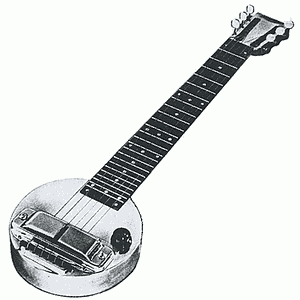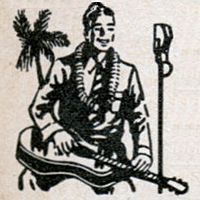Lap Steel Timing and Scale Runs
Learning Scale Runs
 Many
of Jerry Byrd's performances seem impossible to imitate or even come close
in playing; but they are simply notes and techniques. Jerry Byrd (1920-2005)
had the same hands and mind that you or I have, it's just a matter of
spending the time to learn the techniques and skills. Jerry is right... All
the talent in the world means nothing if you don't have desire.
Many
of Jerry Byrd's performances seem impossible to imitate or even come close
in playing; but they are simply notes and techniques. Jerry Byrd (1920-2005)
had the same hands and mind that you or I have, it's just a matter of
spending the time to learn the techniques and skills. Jerry is right... All
the talent in the world means nothing if you don't have desire.
Familiarity is half the battle in learning to play any composition of music. If you can write fast, or type fast, or play anything fast on your guitar, then you can playing anything fast if you play it so much until it becomes second nature. You'll never be able to play something fast if you have to continually think of what note is going to come next. You need to play something repeatedly until is comes natural and you don't have to keep thinking of what note comes next.
That's the secret, if you want to call it that, to why jerry Byrd was able to play so fast, flawlessly, with bouncy rhythm, and looked relaxed while doing it... that is, because he knew what he was playing so well that he didn't have to think about which notes to play next. You and I have to think which notes need to come next, which is why we play slow and with much less grace; but I'll guarantee you that if you'll play a song every day until you know it forwards and backwards that you'll see a drastic improvement in your style and playing. The biggest challenge then is two-fold:
-
overcoming the lack of desire to apply one's self to work hard at playing a song.
-
knowing what to play.
There is no tablature for most great music performances, so you have to learn to figure it out for yourself, which can be extremely difficult to the newer player. I've been playing for a couple decades, which is the only reason I'm able to figure some of this stuff out. I have made it easier for you by figuring out some of Jerry Byrd's most difficult performances. It is tremendous stuff to learn and play! I hope to encourage others to play the lap steel, especially beautiful Hawaiian and melodic music. Take someone to the islands today and lift a burdened heart.
To get started in your timing, you're going to love this MP3 steel guitar clip (WMA) from The Hukilau Song. This is great timing and you can hear it. Study this composition of music very carefully and spend some time with it. Notice every nuance and detail. Keep practicing it over and over until you can play it EXACTLY as it sounds. This is important. So many times steel guitar players just play something that works or is in the ballpark, but you'll NEVER improve your skills that way. You need to carefully study what is being played, why it sounds different than yours, and what you need to do to play it exactly as it is being played in the recording.
Listen if each note is being picked directly on fret, or if there is a slide going into or away from the note. Note in the clip where there is a short PAUSE on a particular note, adding emphasis to that note. That's one of my favorite techniques, which you can hear again in this Harbor Lights Clip (you can hear the last note paused at the end. Here's the tabs for the composition that I played in Harbor Lights...
E_________5~~3_______________*The last note is paused_____________
C_______________4~~2__________on purpose for effect.______________
A______________________*1_____This piece of music can be__________
G___4__5______________________used in many other songs.___________
E_____________________________The goal is to play the last 5______
C_____________________________notes seamlessly to sound Hawaiian._
This is a really great technique to learn, and it's all about becoming skillful with your timing). I cannot stress the importance of timing in music. In fact, I'd goes as far as to say it's probably the most deciding factor between a mediocre musician and a great musician. Jerry Byrd has impeccable timing. All the chord theory in the world will not do you any good without good timing.
The encouraging thing is that timing CAN be learned, even if you feel that you are severely challenged in this area. That's why I put this webpage together... to help you become better at your timing. It takes work, like everything else worthwhile in life.
The idea is not to play exactly like someone else, but rather, to learn to study the performances of others and understand how they are approaching and playing a particular piece of music. You can play it anyway you want later, but at least you will have learned a new way to play something the way another person plays it. This is how you will learn to be a much better steel guitarist. If you'll do what I am suggesting, it will quickly change your style into that of a better musician. Always be listening for new ideas and sounds to incorporate into your steel guitar repertoire of things to play. I hear many musicians who are stuck in 1st gear, playing the same things over and over, and it's because they have never broadened their horizons to think outside the box. Study this MP3 steel guitar clip (WMA) from The Hukilau Song.
Notice the open string work at the end. Here's the tabs...
E___0___0___0___0_________________________________________________
C___0___0___0___0___0___0_________________________________________
A___________________0___0_________________________________________
G___5___4___2___0_________________________________________________
E___________________2___0_________________________________________
C_________________________________________________________________
The following is a wonderful performance by Jerry Byrd playing accompaniment to Hank Snow. The song title is, My Little Grass Shack. Jerry plays a beautiful SCALE RUN at the beginning, which is a Hawaiian steel guitar technique that I rarely ever hear anybody play today. Here's the tabs. The first part is just the intro that I thought you'd like to learn, but the second set of tabs is the ones I want you to notice and learn here, teaching the use of scale runs...
E______________________0_1__4_5_8_12~13___________________________
C______2_3_4_4_2_______0_0________________________________________
A__3_3___________3_2_1_1_0______8_11~12___________________________
G___________________________4_5___________________________________
E_________________________________________________________________
C#________________________________________________________________
Notice the following excellent scale run...
E_________________________________________________________________
C_________________4_5_6_7_6_5_4___________________________________
A_________2_3_4_5_______________5_________________________________
G_____2_3_________________________________________________________
E___3_____________________________________________________________
C#________________________________________________________________
MEMORIZE this scale run and try to use it in other songs, because scale runs are an integral characteristic and essence of Jerry Byrd's Hawaiian style. That is of course, if you're like me and want to play as much like Jerry Byrd as possible. Jerry didn't just have his own style, he nailed it perfect. I doubt if anyone could have ever played Hawaiian music as perfect as Jerry Byrd. I wouldn't choose anything different. I'd want to play it the same way. When I hear Jerry Byrd playing, I say to myself... "Now that's how Hawaiian music should sound." To each his own, but I want to play as much like Jerry's style as possible, which is a gift from God. Music, health, and the ability to play music are all precious gifts from God.
One of Jerry Byrd's most beloved songs is When Hilo Hattie Does the Hilo Hop. The song seemed difficult to play at first. I spent much time trying to learn the song and it became very simple and easy after a while. It's not difficult at all. I made a Band-in-a-Box Rhythm Track, at 110 tempo, with a solo. I studied Jerry Byrd's recording piece-by-piece. It's really just a combination of little pieces all put together. The timing is the most important thing to lean about playing steel guitar, which is difficult for some people. If you have trouble with timing, try to play in timing with rhythm tracks. I always use rhythm tracks.
At 1:26 in THE HUKILAU SONG, you'll hear me doing a scale run, another Hawaiian technique that you ought to learn.
I am speaking primarily about scales here and playing in and out of the scales. Anyone
can just play a melody, but learn to go back and learn to weave through your chords and
a whole new world opens up to you. Here's one example of what I mean, taken from my
recording of the Hukilau Song. You'll hear it right after the clip starts playing.
Here's the tabs for what I'm playing that I want you to see and learn.
E_________________________________________________________________
C_________________________________6__7__8_________________________
A_____________________5__6__7__8________8_________________________
G_________3__4__5__6____________________8_________________________
E___4__5________________________________8_________________________
C_________________________________________________________________
If you'll learn to look for opportunities in your music to make use of chord scale runs
like that, it'll greatly enhance your songs. There's a really nice run in this song by
Jerry Byrd, "When Hilo Hattie Does the Hilo Hop." Here's the same tabs that I gave you
earlier for it. This is a beautifully thought out work of music by Jerry.
You can hear my play it hear. Here's another version I did.
E__8_8_____________________5_____5_6_7_8___6_____________9_10~____
C______9~___________6____6_____6_____________7________________11~_
A_______________5_6____6_______________________7_6_5_6_7~_________
G________5__5_5___________________________________________________
E_________________________________________________________________
C#________________________________________________________________
Here's another great run by Jerry Byrd in "Song of the Islands"...
E________5__~8____________~6__5__3_____________________3__5__~8___
C______5_________12__~12____________2__4___5_______4_5____________
A___________~8___12__~12____________2____________5________________
G__5_5___________11__~12_______________3___5___5__________________
E____________________~12___________________5______________________
C#________________________________________________________________
The following (continued) is genius and what I wanted you to see and learn...
E___8______________5____________________________5~7~12~11~10______
C______9__8__7__6_____6__5__4_________________5___________________
A______________________________5~4~3_____4~5______________________
G_____________________________________4___________________________
E_________________________________________________________________
C#________________________________________________________________
E___9__10__11__12~~10_______________________5_____________________
C___9__10__11__12~~10__12~10~9~10___4___5___5__6~7~8~9~12_________
A______________________12~10~9~10_______5______6~7~8~9~12___5__4__
G___________________________________3___5_________________________
E_______________________________________5_________________________
C#________________________________________________________________
Here's my humble attempt to play When Hilo Hattie Does the Hilo Hop (MP3). HERE'S THE TABS AND NUMEROUS RHYTHM TRACKS FOR "WHEN HILO HATTIE DOES THE HILO HOP." It's crude for having spent one day on the song. I wouldn't put this on an album, but I made it just for the tabs and this article. I tried to record it the next day again with my 1953 S-6 Bakelite Rickenbacker and here's what I got. I'm using the exact same BB rhythm track I've provided to you above. Here it is again. I used one of BB's real instruments, an electric guitar, for the solo. I like how the Ukelele descends in chord progression for the intro. I tried to follow the original song on Jerry's album as much as possible. Here's the BB file if you have Band-in-a-Box on your computer, so you can mess with it if you'd like. The file won't open without a recent version of BB and the latest styles disks (as of 2010).
I recorded directly into a BOSS BR-600 recording unit, playing the song on my AIRLINE S-6 steel guitar (Sears and Roebuck used to sell them decades ago. I paid $75 for it 15 years ago in the Trading Times). I'm using only a BOSS 63 Reverb pedal for effects. I also used a volume pedal in an attempt to sound a little like Jerry Byrd. Jerry used a volume pedal on his recordings, which you MUST have if you want to recreate some of his beautiful sounds. Just a standard volume pedal is fine. Use of the volume pedal is an art and requires good technique in itself.
Here's the tabs for some other interesting things I play in the song, which I made up. This is a great scale exercise. I learned this simply from messing around with scales. This is so important to learning to be a great musician...
E________________________________________________________________________
C________________________________________________________________________
A__3_______3____________________6__7_6_7__6__5_4_5__4____________________
G______2_3_____5_4_5__6__7_6_7_________________________5_4_5__6__7_6_7___
E____3___________________________________________________________________
C#_______________________________________________________________________
Good luck and take someone to the islands today with your music!
~By David J. Stewart
Take someone to the islands today with your music!

If all you have is music, you have nothing! You need Jesus Christ as your personal Savior to truly be prosperous in life. You may be the poorest man in the world materialistically, but if you have received Jesus as the Christ, the Son of God; believing on His name to forgive your sins, then you are a rich soul indeed!
John 20:31, “But these are written, that ye might believe that Jesus is the Christ, the Son of God; and that believing ye might have life through his name.”


